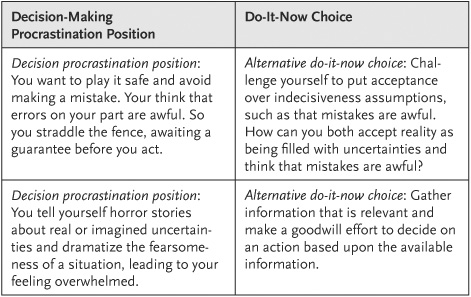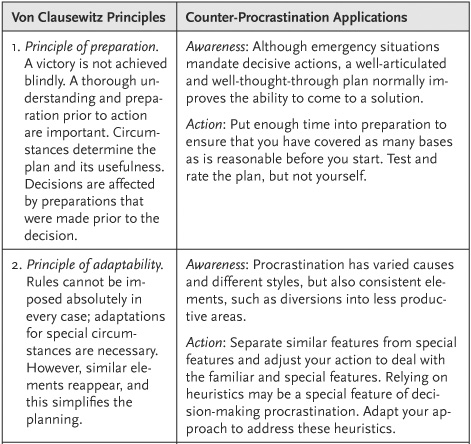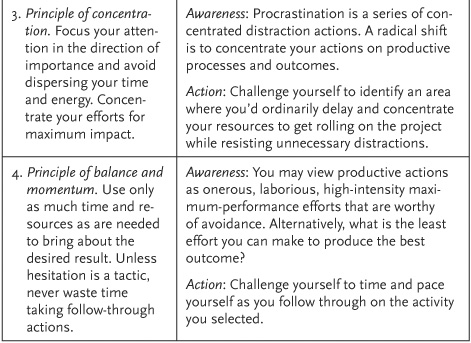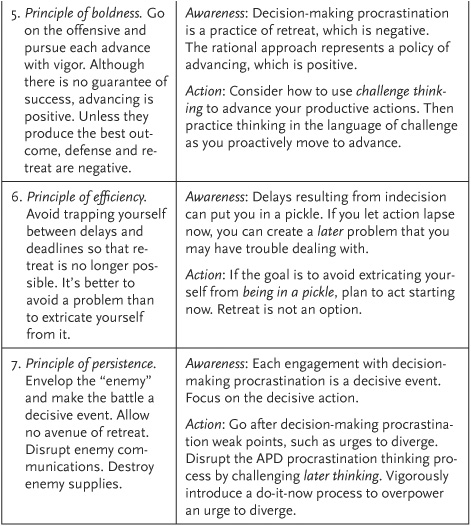End Procrastination Now! (17 page)
Read End Procrastination Now! Online
Authors: William D. Knaus

Is it the situation or what you make of it that stirs anxiety over uncertainty that can lead to decision-making procrastination? The situation is the stimulus. It is not the cause. Rather, it's both the situation and how you view it that influence what you decide. Your decision may also be affected by what you think about the process of executing the decision and the results you anticipate. These considerations can lead to dancing around a decision or moving directly toward making a choice and following through with action.
Although hesitation in uncertain situations is normal, hesitation plus procrastination suggests a complex form of procrastination. For example, feeling frozen by indecision is a probable symptom of anxiety over uncertainty.
Table 5.1
gives sample decision-making procrastination distractions and sample do-it-now choices.
TABLE 5.1

Although there is no sure formula that can guarantee the correctness of a decision before the results are in, inaction caused by indecisiveness is the wrong decision in the vast majority of situations. Act on the 49/51 principle: if you have a slight leaning in one direction, take that direction until the results suggest following a different path. How do you decide the percentages? There is no perfect solution, especially when a decision could go either way. Figure out the pros and cons of each direction, and the picture may begin to clear and give you weight to one direction over another.
What if you don't recognize a decision-making procrastination problem, yet you suffer from the results of indecision? There is not much you can do. A big part of solving a decision-making procrastination problem is to recognize the problem. This can be tricky when different styles of procrastination coexist.
Decision-making procrastination can be cinched by other procrastination styles, such as blame avoidance procrastination, in which you defer a decision to avoid risking criticism. If you tend to follow a behavioral procrastination path, you decide on a direction, establish goals, and generate a strategic plan to meet your objective. Then it comes time for you to execute your plan. You are uncertain what to do when you meet your first barrier. In good behavioral procrastination fashion, you put off following through. When styles interconnect because of, say, uncertainty anxieties, you have the usual two problems to resolve: following through on the counter-procrastination action while addressing the co-occurring condition.
Information from this book can help clarify conditions in which procrastination is a problem condition, and the following problem-solving list covers how to meet this form of challenge:
1. A problem exists when you have a gap between where you are and where you'd like to be. The gap contains unknowns, and solving the problem is ordinarily going to require an evaluation, generating solutions, testing the solutions, and overpowering coexisting procrastination processes when they interfere with preparation for and execution of the solutions.
2. A lot depends on how you define a problem situation. A well-articulated question can help point you in a direction where you can find answers. Directions for solutions are often built into such questions. For example, what steps are involved in ending decision-making procrastination that applies to your situation? This question focuses on the problem and the importance of identifying steps for a solution.
3. Next, define the problem conditions. New questions can stimulate answers that expand and clarify problem-related issues. What, where, when, how, and why questions help to flesh out problem identification issues.
What
pressing decisions are you likely to duck?
Where
is this likely to occur? At what point (
when
) are you most likely to delay? What do you tell yourself when you hesitate?
Why
do you think you find it so troublesome to decide this issue? Play with different scenarios in which you reverse the questions to give direction to acting efficiently and effectively.
4. Reframing problems can lead to different options and conclusions. The idea is to reframe the situation so that you move from a procrastination to a do-it-now track. Use questions to reframe the process. What if my assumptions are inaccurate? What assumptions are likely to be accurate? What other assumptions can I consider? Imagine that your decision leads to unexpected consequences (which can be positive, negative, or both) without putting down or praising yourself. Obtain three alternative views from three people who ordinarily have different perspectives.
In solving a well-articulated problem, you may have many false runs in which you test solutions that don't solve the problem. You may find solutions that are good enough but not perfect. However, once you engage the decision-making process, you are likely to find ways to actualize your capabilities by stretching them.
American diplomat and scientist Ben Franklin stated in his autobiography that by setting goals and striving to reach them, he found that he was not perfect, but he was still far better off than he would have been if he had not undertaken the challenges he set for himself.
Problem solving may go into a holding pattern when decision-making procrastination gets in the way.
Table 5.2
compares a decision breakdown process to a rational decision-making process.
The comparison in the table provides another way to view a Y decision: as a shift from a decision breakdown process to a rational process of making decisions based on concrete realities, where you weigh and balance choices, then act on the best option available at the time. When you face a Y decision between retreating and advancing, use this breakdown-rational contrast. It may be useful to ask who is calling the shots, the horse or the rider?
TABLE 5.2

The nineteenth-century Prussian military strategist Carl von Clausewitz's book
On War
has attracted interest from people in the business world who are interested in strategic planning. Its strategic planning content is of value to organizations that want to establish momentum, moving forward in changing circumstances where adaptation is critical. You can apply this same approach to improving the quality of your decisions, getting out of an indecision holding pattern, and enjoying the fruits of your productive labors.
Von Clausewitz's approach centers on strategic planning and execution. He starts by defining strategy as the planning of a campaign that includes the coordination of tactics to achieve the main objective. These tactics are smaller-scale plans to manage each individual encounter. You can apply both strategy and tactics to go against procrastination and to end procrastination.
END PROCRASTINATION NOW! TIP
:
DECIDE
D
ecisions are inescapable, so you might as well decide to decide.
E
nter areas of uncertainty to gain clarity and direction.
C
onsider alternatives and consequences. Include the consequences of inaction.
I
mplement problem-solving actions.
D
etermine what works and what doesn't and what could be useful with modifications.
E
ngage the next challenge and persist in actualizing your positive capabilities.
TABLE 5.3



Table 5.3
describes seven principles that I abstracted from von Clausewitz's book. His main message is to keep focused on what is important and to time and pace your actions efficiently. The principles and an application example are given in the table.
Here is a general principle for your battle to contest decision-making procrastination. You enter areas of uncertainty with a plan. Through executing your plan, you gain clarity and direction. You
can apply this general principle (strategy) as you address both decision making and the other procrastination styles.